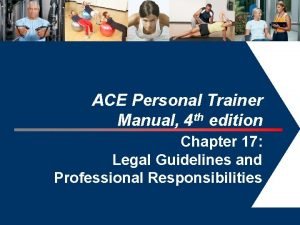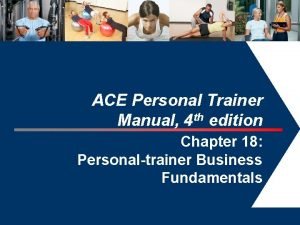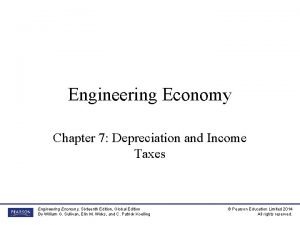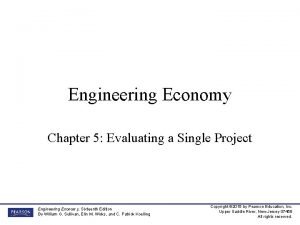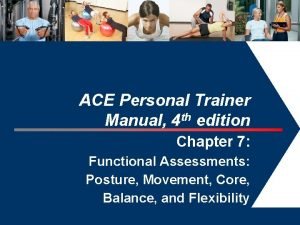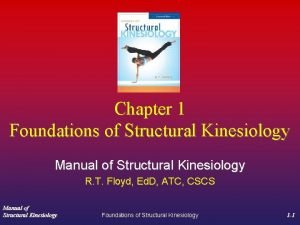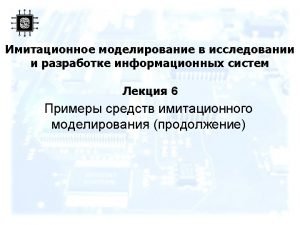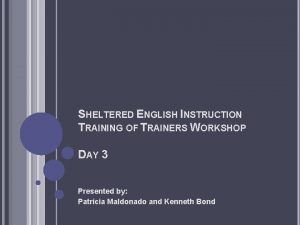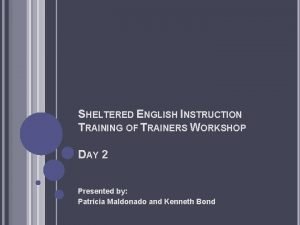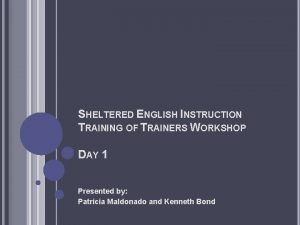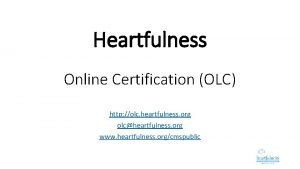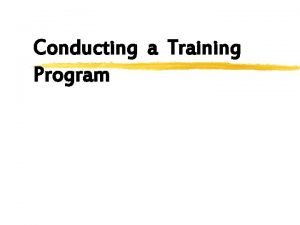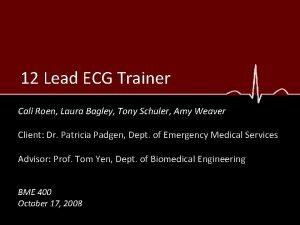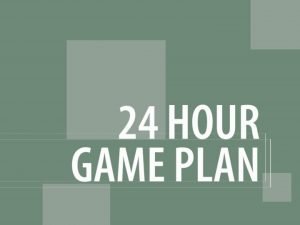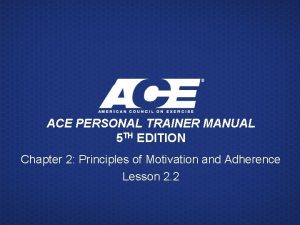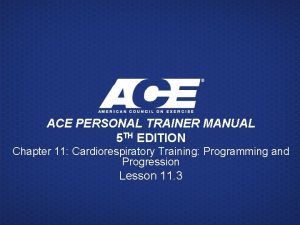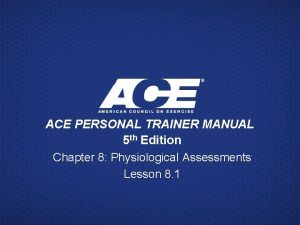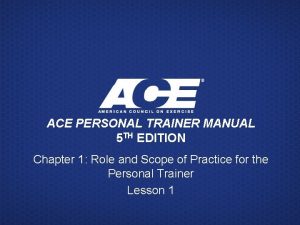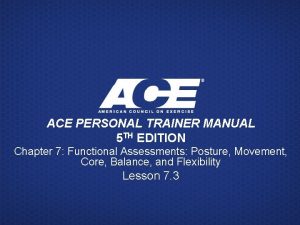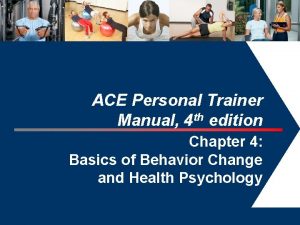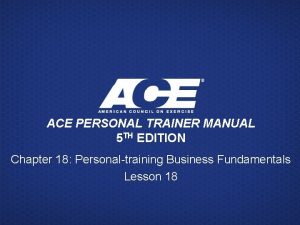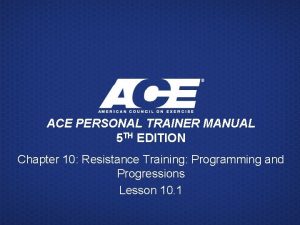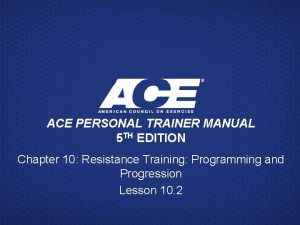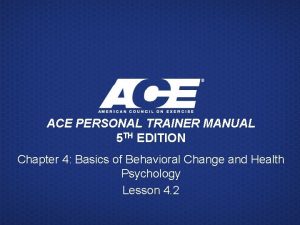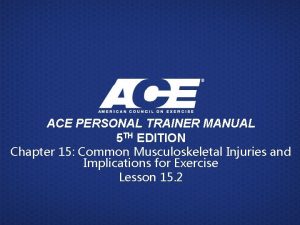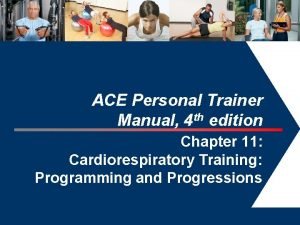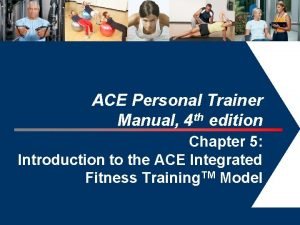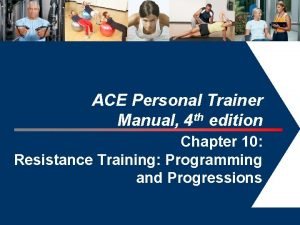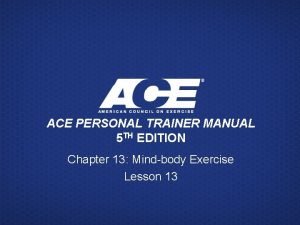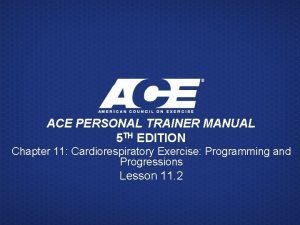ACE PERSONAL TRAINER MANUAL 5 TH EDITION Chapter




























- Slides: 28

ACE PERSONAL TRAINER MANUAL 5 TH EDITION Chapter 5: Understanding the ACE Integrated Fitness Training® Model Lesson 5. 2

LEARNING OBJECTIVES • After completing this session, you will be able to: ü List the key steps that facilitate fitness-related behavioral change ü Describe the training phases and goals of functional movement and resistance training, and the principles they are based on (i. e. , specificity, overload, and progression) ü Describe training phases and the goals of cardiorespiratory training, including an understanding of ventilatory thresholds ü Evaluate adaptations to training phases when working with a special population client © 2014 ACE

FACILITATING FITNESS-RELATED BEHAVIORAL CHANGE • Personal trainers can have the greatest impact on the lives of their clients by: ü Creating a positive exercise experience first ü Helping clients modify behavior to establish a habit of regular activity © 2014 ACE

FACILITATING FITNESS-RELATED BEHAVIORAL CHANGE • After two to four weeks of regular activity, clients will experience more stable positive moods due to: ü Changes in hormone and neurotransmitter levels (e. g. , endorphins, serotonin, and norepinephrine) ü Increased self-efficacy with tasks and short-term goal achievement ü Improved performance due to the positive neuromuscular adaptations to exercise • Personal trainers should make exercise fun and emphasize regular adherence to a program. © 2014 ACE

FACILITATING FITNESS-RELATED BEHAVIORAL CHANGE Key steps that facilitate fitness-related behavioral change include: • Implementing strategies for developing and enhancing rapport • Identifying each client’s readiness to change behavior and stage of behavioral change • Fostering exercise adherence by creating positive exercise experiences and building self-efficacy • Appropriately selecting and timing assessments and reassessments • Designing programs, supervising workouts, and implementing progressions that match each client’s current health and fitness status, needs, and goals • Fostering a sense of self-reliance to enable clients to take ownership of their lifestyle changes • Helping clients transition to the action and then maintenance stages of behavioral change © 2014 ACE

FACILITATING FITNESS-RELATED BEHAVIORAL CHANGE Key steps that facilitate fitness-related behavioral change include: • Implementing relapse-prevention strategies • Helping clients transition from extrinsic to intrinsic motivation • Establishing realistic short- and long-term goals to prevent burnout, provide multiple opportunities for success, and promote adherence • Providing extrinsic motivation and introducing visualization techniques during performance training • Factoring a client’s external stresses into total fatigue to avoid training plateaus and prevent overtraining • Empowering clients by helping them gain the self-efficacy and knowledge to train on their own • Helping clients make exercise a long-term habit © 2014 ACE

ACE IFT MODEL TRAINING COMPOINENTS AND PHASES • The ACE IFT® Model provides a comprehensive training model for function, health, fitness, and performance that can be implemented with all apparently healthy clients. © 2014 ACE

THE ACE IFT MODEL © 2014 ACE

FUNCTIONAL MOVEMENT AND RESISTANCE TRAINING • Phase 1: stability and mobility training ü Focuses on improving the client’s posture by introducing lowintensity exercise programs that address: o o o Muscle balance Muscular endurance Core function Flexibility Static and dynamic balance o o Posture Balance Movement Range of motion (ROM) of the ankle, hip, and shoulder complex, and thoracic and lumbar spine ü Basic assessments conducted early in this phase include: © 2014 ACE

FUNCTIONAL MOVEMENT AND RESISTANCE TRAINING • Exercises in phase 1 should: ü Emphasize supported surfaces that offer stability (e. g. , floor or backrests) • Promote stability by focusing on: ü Restorative flexibility ü Isometric contractions ü Limited-ROM strengthening ü Static balance ü Core activation ü Spinal stabilization ü Muscular endurance © 2014 ACE

FUNCTIONAL MOVEMENT AND RESISTANCE TRAINING • Phase 2: movement training ü Focuses on training movement patterns. ü Movement training focuses on the five primary movements: o Bend-and-lift movements (e. g. , squatting) o Single-leg movements (e. g. , lunging) o Pushing movements o Pulling movements o Rotational (spiral) movements © 2014 ACE

FUNCTIONAL MOVEMENT AND RESISTANCE TRAINING • Exercises in phase 2 should: ü Emphasize the proper sequencing of movements ü Control of the body’s center of gravity (COG) throughout the normal ROM ü Promote dynamic balance and active flexibility ü Build muscular endurance and promote mobility ü Emphasize controlled motion and deceleration performed via controlled eccentric muscle actions © 2014 ACE

FACILITATING BEHAVIORAL CHANGE Spend a few minutes thinking of how you move during your typical activities of daily living. Can you recognize these five primary movements in your normal behavior? This can be a valuable teaching tool when working with clients who question the need for this early-phase training. © 2014 ACE

FUNCTIONAL MOVEMENT AND RESISTANCE TRAINING • Phase 3: load training ü Phase 3 focuses on increasing the external load, placing emphasis on muscle force production. ü Exercise variables are consistent with the standard FITT-VP model for increasing: o Muscular hypertrophy o Enhancing muscular endurance o Improving muscular strength © 2014 ACE

FUNCTIONAL MOVEMENT AND RESISTANCE TRAINING • Exercises in phase 3 should include a number of different options, such as: ü ü ü Selectorized or plate-loaded equipment Barbells, dumbbells, or kettlebells Medicine balls Elastic tubing Non-traditional strength-training equipment • Focus is on good form and increasing the ability of muscles to generate force • May utilize linear or undulating periodization models • May focus on single-joint movements and transition to full-body movements • May be performed as split routines, circuit training style, or all major muscle groups during the program © 2014 ACE

FUNCTIONAL MOVEMENT AND RESISTANCE TRAINING • Phase 4: performance training ü Focuses on specific training to improve speed, agility, quickness, reactivity, and power. • Power training: ü Enhances the velocity of force production ü Improves the ability of muscles to generate a large amount of force in a short period of time ü Is appropriate for sports and activities that require repeated acceleration and deceleration ü Develops lean muscle and enhances muscle size and definition © 2014 ACE

FUNCTIONAL MOVEMENT AND RESISTANCE TRAINING © 2014 ACE

CARDIORESPIRATORY TRAINING COMPONENTS AND PHASES © 2014 ACE

CARDIORESPIRATORY TRAINING • Phase 1: aerobic base training focuses on: ü Developing an initial aerobic base in those who are sedentary or near-sedentary ü Building the foundation for training for cardiorespiratory fitness in phase 2 ü Developing a stable aerobic base upon which the client can build improvements in: o o o © 2014 ACE Health Endurance Energy Mood Caloric expenditure

CARDIORESPIRATORY TRAINING • Exercise during phase 1 should be: ü Performed at steady-state intensities ü Low-to-moderate range ü Consistent with the range of guidelines for cardiorespiratory exercise ü Initially be of an appropriate duration that the client can tolerate • The goal for all clients in this phase is to gradually increase: ü Frequency to three to five days per week ü Duration to 20 to 30 minutes ü Ratings of perceived exertion (RPE) to 3 to 4 © 2014 ACE

CARDIORESPIRATORY TRAINING • Phase 2 focuses on enhancing the client’s aerobic efficiency by: ü Increasing the duration of sessions ü Increasing the frequency of sessions ü Introducing aerobic intervals at or just above the first ventilatory threshold (VT 1) or at an RPE of 5 ü Improving the client’s ability to utilize fat as fuel • Aerobic intervals add variety and can differ in: ü Number and length of work and rest intervals ü Speed ü Incline ü Resistance © 2014 ACE

CARDIORESPIRATORY TRAINING © 2014 ACE

CARDIORESPIRATORY TRAINING • Phase 3: anaerobic endurance training ü Programming focuses on: o o Improving performance for higher levels of cardiorespiratory fitness Introducing higher-intensity intervals ü Balancing training time: o o o Below VT 1: 70– 80% Between VT 1 and second ventilatory threshold (VT 2): >10% At or above VT 2: 10– 20% ü Depending on the client’s goal, a client may train: o o © 2014 ACE Three to seven days per week 20 minutes to multiple hours in length

CARDIORESPIRATORY TRAINING © 2014 ACE

CARDIORESPIRATORY TRAINING • Phase 4: anaerobic power training ü Focuses on introducing new intervals that are: o Designed to develop peak power and aerobic capacity o Designed to overload the fast glycolytic system and challenge the phosphagen system o Short-duration, high-intensity o Below VT 1: 70– 80% o Between VT 1 and VT 2: >10% o At or above VT 2: 10– 20% ü Require intrinsic motivation to meet the physical and mental challenge ü Depending on the client’s goals, a client may train: o Three to seven days per week o 20 minutes to multiple hours in length © 2014 ACE

CARDIORESPIRATORY TRAINING © 2014 ACE

SPECIAL POPULATION CLIENTELE • Personal trainers working with special population clients should: ü Promote adherence through initial successes and a positive exercise experience ü Utilize the ACE IFT Model ü Adjust exercise selection, intensity, sets, repetitions, and duration • Transitioning a special-population client to the maintenance stage of behavioral change may have a positive impact on the client’s state of physical and mental well-being. © 2014 ACE

SUMMARY • The ACE IFT Model offers personal trainers a systematic approach to providing integrated assessment and programming solutions. • Each phase provides appropriate levels of programming to improve function, health, basic fitness, advanced fitness, and performance. • Each training component—functional movement and resistance training, and cardiorespiratory training—allows the personal trainer to provide comprehensive training solutions that are appropriate for each client’s current health, fitness, and goals. • The central focus of creating positive experiences that develop and enhance program adherence is crucial to success for all clients and will set a personal trainer apart from peers who are more focused on sets and repetitions. © 2014 ACE
 Personal trainer liability insurance ace
Personal trainer liability insurance ace Personal trainer swot analysis
Personal trainer swot analysis Engineering economy 16th edition solution manual chapter 5
Engineering economy 16th edition solution manual chapter 5 Engineering economy 16th edition solution manual chapter 5
Engineering economy 16th edition solution manual chapter 5 Engineering economy 16th edition chapter 3 solutions
Engineering economy 16th edition chapter 3 solutions Plumb line posture
Plumb line posture Using mis (10th edition) 10th edition
Using mis (10th edition) 10th edition Report
Report Manual of structural kinesiology 18th edition
Manual of structural kinesiology 18th edition Chapter 8 personal finance
Chapter 8 personal finance Anylogic personal learning edition
Anylogic personal learning edition Good trainer qualities
Good trainer qualities Train the trainer objectives
Train the trainer objectives Luke trainer clark the boy who cried wolf
Luke trainer clark the boy who cried wolf Sheltered trainer
Sheltered trainer Sheltered trainers
Sheltered trainers Sheltered trainers
Sheltered trainers Cisco certified instructor
Cisco certified instructor My csudh portal
My csudh portal Mct enrollment tool
Mct enrollment tool Azure certification poster
Azure certification poster Heartfulness preceptors
Heartfulness preceptors Good trainer qualities
Good trainer qualities Example of malfeasance in athletic training
Example of malfeasance in athletic training 12 lead trainer
12 lead trainer Underwater escape room
Underwater escape room Siemens sce
Siemens sce Microsoft innovative educator trainer academy
Microsoft innovative educator trainer academy Executive team trainer
Executive team trainer
